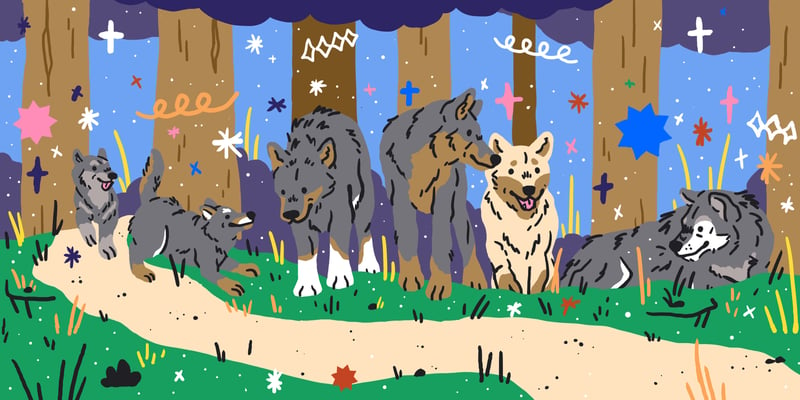Index:



Introduction
As a Shiba Inu owner, I often wonder about my dog’s ancestry and the history behind his breed. When he’s sleeping by my side I quietly think to myself, I’m sharing my home with a descendant of the wolf. If you haven’t already, it’s very likely you’ll encounter many sobering moments where you’re reminded that your dog was once a wild animal.
But whilst it’s our general understanding that dogs come from wolves, surely there's more to it than that? How did we get from wolves to dogs like the French Bulldog or the Bichon Frise? And what causes dog breeds to be so physically different when they all stem from the same source?
To tell you the truth, there isn’t one clear-cut answer. As with most biological studies, we rely on theories to surmise what happened all those years ago. Fortunately, when it comes to cynology, there’s a lot of research and knowledge available to us to understand more about the dogs we consider our closest companions in life.
In this article, we’re taking a look at the theory of natural selection and human influence, the differences between wolves and dogs and how the symbiotic relationship shared between humans and wolves has led us to dogs becoming our best friends.



The theory of natural selection
Though revisiting the theory of natural selection can often feel like a throwback to the science lessons of high school, learning about it in greater detail can help us understand more about our pets and the unique traits they possess. (And unlike your science teacher, I promise to keep it light.)
Roger Tabor, a well-known biologist and author, has contributed significantly to the understanding of animal behaviour, including the domestication of dogs. Tabor believes that domestic dogs (Canis familiaris) are descended from wolves (Canis lupus) and that this transformation occurred through a process of natural selection and human intervention over thousands of years.
Natural selection is a process proposed by Charles Darwin whereby animals that are better suited to their environment are more likely to survive and reproduce. Over time, this means that the traits that help them survive become more common in the population. Simply put, it’s nature's way of picking the best traits to pass on to future generations.
In his writings and teachings, Tabor suggests that the initial stages of domestication likely began when wolves started to scavenge around human settlements looking for food. By doing this, they would secure a steady food source whilst also acting as a warning system to humans against other predators and potential intruders. This transactional relationship thus lays the groundwork for domestication.
Tabor also points out that behavioural changes were crucial in the domestication process. Wolves that were less fearful and more social were more likely to thrive in proximity to humans. Over generations, these traits became more pronounced, leading to the domesticated dogs we know today. In his work, he also highlights the role of humans in actively selecting and breeding wolves for specific traits. This selective breeding further accelerated the development of various dog breeds with specialised functions, such as hunting, herding and guarding.



Genetic similarities and evidence
Dogs and wolves share a remarkable amount of their genetic makeup, with studies indicating that their genomes are about 99.9% identical. This close genetic relationship suggests that dogs are a subspecies of wolves. Specific genetic markers, especially those found in mitochondrial DNA (mitochondrial DNA is the genetic material found in mitochondria, the energy-producing structures in cells), reinforce this connection, showing that dogs and modern wolves diverged from a common ancestor roughly 15,000 to 40,000 years ago.
To help support this theory, fossils of early domesticated dogs have been uncovered in various parts of the world. One notable discovery includes remains from Germany dating back approximately 14,000 years. These fossils exhibit characteristics distinct from those of wolves, indicating early stages of domestication. These changes in skeletal structure, such as differences in skull shape and size, tooth size and limb proportions, reflect adaptations to living with humans.
Archaeological sites provide further evidence of the ancient relationship between humans and dogs. For instance, a 12,000-year-old site in North America contains a burial of a human alongside the remains of a dog, highlighting the special bond and significant role dogs played in human societies even in ancient times. These findings suggest that dogs were not only companions but also held cultural and spiritual significance.
Additional evidence from sites like Bonn-Oberkassel in Germany and Razboinichya Cave in Siberia supports the gradual process of dog domestication. These sites, containing dog remains dating back approximately 14,000 to 15,000 years, showcase a mix of wolf and dog-like traits. This blend of characteristics further illustrates the transitional phase from wild wolves to domesticated dogs, underscoring the deep historical roots of the human-dog relationship.



Early relationships with humans
Early humans and dogs likely formed mutually beneficial relationships through a process of co-evolution. It’s thought that humans transitioned from nomadic lifestyles to more settled communities, wolves with traits that made them less aggressive and more social started scavenging near human camps. These early interactions would have offered mutual advantages: wolves benefited from a reliable food source, while humans gained alert animals that could warn of approaching danger. Over time, the wolves that were tamer and more cooperative would have been more successful in surviving and reproducing, gradually evolving into the domestic dogs we know today.
In early human societies, dogs played several crucial roles. As hunting partners, dogs’ keen senses and agility made them invaluable in tracking and cornering prey. Their ability to guard human settlements and livestock from predators and intruders also provided a significant advantage, enhancing the safety and security of early human communities. And unforgettably, dogs offered companionship, which could have helped strengthen social bonds within groups and improve overall well-being just as dogs help us to do today. The close bond between humans and dogs likely contributed to the survival and success of humans thousands of years ago.
Historical artefacts and cave paintings provide tangible evidence of the early human-dog relationship. For example, cave paintings found in regions such as Europe and Asia depict dogs participating in hunts alongside humans, illustrating their role in cooperative hunting activities. These artefacts and artworks offer a glimpse into how integral dogs were to the daily lives and spiritual practices of early humans.



The evolution of dog breeds
The development of different dog breeds over time is largely the result of selective breeding practices carried out by humans. Initially, early domesticated dogs adapted to their environments and the specific needs of human societies. As humans began to settle and form distinct cultures, they started to selectively breed dogs for particular traits that were beneficial for various tasks such as hunting, herding, guarding and companionship. This selective breeding intensified certain physical and behavioural traits, leading to the emergence of diverse dog breeds suited to specific roles.
Selective breeding has had a significant impact on the diversity of dog breeds. By choosing dogs with desired traits to reproduce, humans were able to enhance characteristics such as size, coat type, temperament and abilities. For example, herding breeds like Border Collies were developed for their intelligence and herding instincts, while hunting breeds like Greyhounds were bred for speed and agility. This intentional selection process has resulted in over 340 recognised dog breeds today, each with unique traits tailored to different human needs and environments.
Some of the oldest known dog breeds trace their origins back thousands of years and provide insights into the history of human-dog relationships. The Basenji, often referred to as the ‘barkless dog’ originates from central Africa and is depicted in ancient Egyptian art. The Saluki, known for its grace and speed, is believed to have been bred in the Middle East over 5,000 years ago. The Akita Inu from Japan and the Chow Chow from China are other examples of ancient breeds with long histories of serving as guard dogs, hunters and companions. These breeds, among others, illustrate the deep historical roots and the diverse roles that dogs have played in various human cultures throughout history.



Conclusion
In conclusion, the origins of dogs are deeply intertwined with human history, beginning with their evolution from wolves through a process of domestication that occurred around 15,000 to 40,000 years ago.
Early humans and dogs formed mutually beneficial relationships, with dogs playing critical roles in hunting, guarding and companionship. Selective breeding over thousands of years has led to the vast diversity of dog breeds we see today, each adapted to specific human needs and environments. Historical artefacts and ancient breeds provide further insights into the longstanding bond between humans and dogs and further cement the importance of our relationship.
Understanding the origins of dogs is significant as it sheds light on the evolution of human societies and the unique bond we share with these animals. It also helps us appreciate the behavioural traits and needs of modern dogs, fostering better care and relationships with our canine companions.
As we continue to explore the history and evolution of dogs, it’s natural to wonder: How will our relationship with dogs evolve in the future, and what new roles might they play in our lives as both technology and society progress?
Waggel Pet Insurance
Need more help? You're in luck if you're a Waggel Pet Insurance member. Along with our excellent coverage, we offer access to a 24/7 online vet to answer all your sticky questions, especially if you need grooming assistance.
Not a member? Why not get a quote now and cover your furry friend for a range of illnesses, all while enjoying our amazing perks and rewards.
Want more like this?
Get updates from us with helpful info, advice, answers to frequently asked questions and much more.
Index:
Related posts:
Get your quote
Along with our excellent coverage, we offer access to a 24/7 online vet to answer all your sticky questions.





